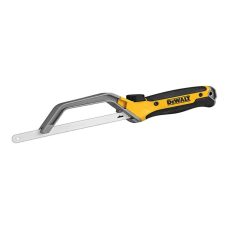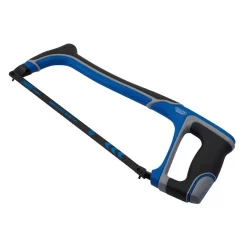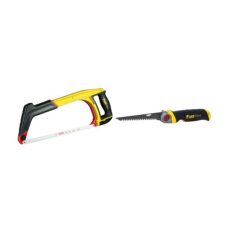Hacksaw Hand Tool
A hacksaw hand tool is an essential tool in any DIY enthusiast’s or professional’s toolkit. Designed for cutting through metal, plastic, and other materials, a hacksaw is versatile and reliable. Available in various sizes and designs, including mini hacksaw, junior hacksaw, and hacksaw frame, these tools provide accurate and efficient cutting. Whether you’re tackling small household tasks or working on larger projects, the right hacksaw ensures a clean, precise cut every time.
Features of a Hacksaw Hand Tool
Versatility in Cutting
The hacksaw hand tool is designed to handle a wide variety of materials. Whether you’re cutting pipes, metal rods, or plastic tubing, this tool is your go-to for precision and accuracy. Models like the mini hacksaw and junior hacksaw are perfect for small, intricate cuts, while larger versions such as the hacksaw with frame are built to handle tougher materials with ease.
Lightweight and Easy to Handle
Most hacksaw frames are designed with a lightweight yet sturdy frame that provides comfort during use. Tools like the junior hacksaw are especially designed for ease of handling, ensuring that both professionals and DIYers can use them effectively for extended periods without strain.
Adjustable Blade Tension
Many hacksaw frames come with an adjustable blade tension feature, which allows you to tighten or loosen the blade depending on the material you’re cutting. This feature ensures consistent and efficient cutting throughout your project.
Compact and Portable
The mini hacksaw is a compact version of the standard hacksaw, making it ideal for tight spaces where larger tools might not fit. Its portability makes it an excellent choice for those who need a cutting tool they can easily carry and use on the go.
Durability and Longevity
Whether you’re using a hacksaw machine or a simple hand-held model, durability is key. The hacksaw frame is made from strong materials like steel, ensuring that your tool will withstand repeated use over time.
Types of Hacksaws
Junior Hacksaw
The junior hacksaw is a smaller version of the traditional hacksaw, designed for precise cuts in smaller materials. It’s perfect for DIY enthusiasts who need a compact and easy-to-use tool for cutting metal, plastic, and wood in tight spaces.
Mini Hacksaw
A mini hacksaw is ideal for light-duty tasks and cutting through thin metal sheets, pipes, or other small materials. Its small size makes it perfect for intricate jobs and for cutting in confined areas.
Frame Hacksaw
A frame hacksaw is a larger, more robust version of the standard hacksaw. Its adjustable frame can hold a variety of blade sizes, making it versatile for cutting through thick metals, plastics, and other tough materials.
Hacksaw with Frame
A hacksaw with frame combines the blade and frame in one unit, offering greater stability and control. This model is particularly useful for those needing a steady, secure cutting experience for larger or tougher jobs.
Why Choose a Hacksaw Hand Tool?
Precision and Clean Cuts
Hacksaws deliver precision cuts. Whether you use a hacksaw with a frame or a junior hacksaw, these tools ensure a clean cut every time and minimize the need for additional finishing.
Cost-Effective and Easy to Maintain
Unlike hacksaw machines, hand tools are affordable and simple to maintain. Changing the blades or adjusting the tension is straightforward, and the tools require minimal care.
Suitable for Various Applications
A hacksaw hand tool is suitable for a range of applications, from DIY repairs to professional tasks. Whether you’re working on plumbing, electrical projects, or general construction, the versatility of the hacksaw makes it indispensable in every toolbox.
Ideal for Tight Spaces
Compact versions like the mini hacksaw and junior hacksaw are ideal for cutting in tight or confined spaces where larger tools cannot reach.
How to Choose the Right Hacksaw Hand Tool
- Consider the Task at Hand:
For light tasks like cutting thin metal or plastic, a mini hacksaw or junior hacksaw is ideal. For tougher jobs, a frame hacksaw or hacksaw with frame is more suitable. - Material of the Blade:
Ensure the blade is suited for the material you’re cutting. For example, a blade designed for metal cutting will differ from one used for plastic or wood. - Comfort and Control:
Look for a hacksaw with an ergonomic handle that offers a secure grip for extended use, ensuring comfort during your project. - Adjustable Features:
If you’re tackling various materials, choose a hacksaw with frame that has an adjustable blade tension feature for added flexibility.
Conclusion
The hacksaw hand tool is a must-have for anyone looking to make clean, precise cuts in a variety of materials. Whether you choose a mini hacksaw for intricate tasks, a junior hacksaw for smaller projects, or a hacksaw with frame for larger, tougher cuts, you’ll find the perfect tool to fit your needs. With durability, portability, and ease of use, these tools provide the versatility required for both DIY and professional tasks.
Investing in a hacksaw hand tool guarantees efficiency, precision, and a clean finish, making it an indispensable part of any tool collection.



